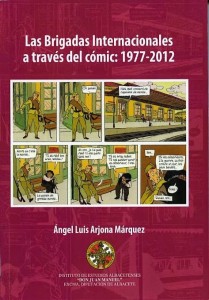Book Review: International Brigades Comic
 Ángel Luis Arjona Márquez’s Las Brigadas Internacionales a través del cómic: 1977-2012 offers a new perspective on one of the most symbolically and ideologically charged aspects of the Spanish Civil War: the mobilization of thousands of volunteers who travelled to Spain to defend the progressive ideals associated with the Second Republic. Using comics as primary source material, Arjona hints at some interesting socio-cultural questions. How have representations of these international defenders of the Spanish Republic changed during the decades following Spain’s transition to democracy? In what ways can these representations be said to reflect Spanish society’s changing relationship to its own contemporary history? More specifically, in what ways do representations of the International Brigades found in comics differ from their portrayal in other media? These questions were no doubt present as the author conducted his investigations, yet it will be up to future research to deliver the answers. This book does not provide broad socio-cultural analysis. Instead, being the first investigation of its kind, the author has understandably focused on establishing the concrete facts relating to his subject.
Ángel Luis Arjona Márquez’s Las Brigadas Internacionales a través del cómic: 1977-2012 offers a new perspective on one of the most symbolically and ideologically charged aspects of the Spanish Civil War: the mobilization of thousands of volunteers who travelled to Spain to defend the progressive ideals associated with the Second Republic. Using comics as primary source material, Arjona hints at some interesting socio-cultural questions. How have representations of these international defenders of the Spanish Republic changed during the decades following Spain’s transition to democracy? In what ways can these representations be said to reflect Spanish society’s changing relationship to its own contemporary history? More specifically, in what ways do representations of the International Brigades found in comics differ from their portrayal in other media? These questions were no doubt present as the author conducted his investigations, yet it will be up to future research to deliver the answers. This book does not provide broad socio-cultural analysis. Instead, being the first investigation of its kind, the author has understandably focused on establishing the concrete facts relating to his subject.
How have representations the International Brigades changed over time?
On this score, the book delivers impressively. After extensive research, the author has identified not only titles in which the International Brigades appear as the main protagonists, but also comics in which the International Brigades play a peripheral role. Even if the reader is reminded that new relevant titles may still be found, the list presented seems exhaustive for the time period covered (1977-2012). The author also describes the development of the comic in Spain and provides brief biographies of many writers and illustrators. The 160-page Appendix, which includes many color reproductions of extracts from relevant comics, as well as extensive lists of a wide variety of sources (including many Internet-based options), adds significant value to the book and will clearly be useful for future researchers. But for readers with more general historical interests, the book suffers from certain weaknesses.
First, the book contains several, and sometimes lengthy, introductory sections that oblige the reader to wait a long time before encountering any concrete information. More could also have been done to analyze the most important comics in this context. The section devoted to comics based on the history of the International Brigades is mostly descriptive, consisting of plot summaries listed one by one. Historical information is added to place the action within the overarching development of the Spanish Civil War, but the book could have benefited from a more developed thematic analysis. Finally, as hinted above, the author says little regarding the question of what these representations in themselves may say about collective memories of the Spanish Civil War. Such questions can only be given speculative and preliminary answers in a work like this, but it is a shame that the author does not attempt a more elaborate exploration in this regard.
Still, it would be wrong to end on a negative note. Ángel Luis Arjona is knowledgeable about both comics and the history of the International Brigades. His book is a valuable reference for anyone interested in visual representations of the Spanish Civil War during the transition and more recent decades.
Carl-Henrik Bjerstrom is a Lecturer in Modern European History at Birkbeck, University of London. Professor Bjerstrom studies cultural mobilisation during the Spanish Civil War, which was the subject of his Ph.D dissertation ‘Re-imagining the Nation: Josep Renau and the Politics of Culture in Republican Spain, 1931-1939,” completed at Royal Holloway, University of London, in 2014.














